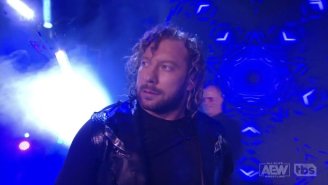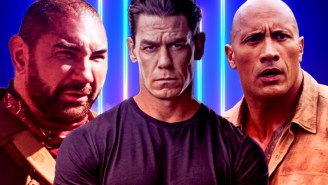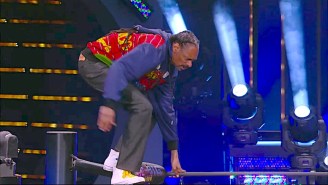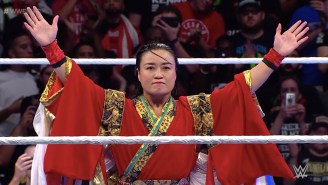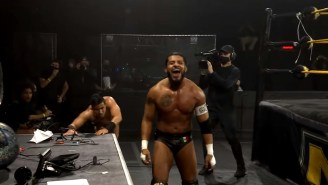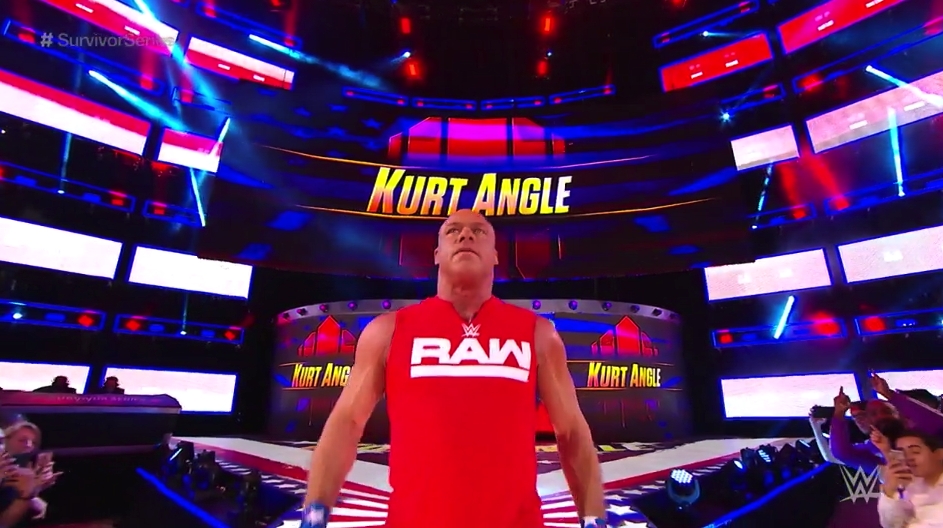
WWE will present the 2018 iteration of Survivor Series on Sunday, and as of this writing, Hall of Famer Kurt Angle is not on the card. According to recent reports, the former Raw general manager may have actually been written out of previous plans to appear at Survivor Series, as he was last seen losing a lopsided match to Drew McIntyre. That match — Angle’s first singles match on Raw in 13 years — was for a spot on the Raw men’s Survivor Series team, and was structured to make it look like Angle was over the hill, and that McIntyre is a fearsome monster, and the future.
If Angle is indeed off Survivor Series (and that’s a big if, as injuries and other things have the company completely up in the air right now, and anything is liable to happen at any time), it’s unfortunate, and it might hit close to home for the Olympic gold medalist, as he made his televised WWE debut at Survivor Series nearly 20 years ago, and his history on the “Big Four” show is a long and complicated one.
Angle debuted at Survivor Series on November 14, 1999, the first of seven consecutive Survivor Series appearances. He would then depart to TNA (later Impact Wrestling) for over a decade before finally returning to WWE in 2017. Later that same year, he would appear in the main event of his eighth Survivor Series … and what very well may be his last.
Taken together as a collection, Angle’s Survivor Series appearances tell a nearly complete story of his professional wrestling career (at the very least, a complete story of his WWE career to date), as he moved through several incarnations of the same character in short order before settling into the Kurt Angle that we immediately recognize today. As is always the case in a lengthy wrestling career, it’s all part of a whole, and it’s fascinating to take a step back and observe Angle’s Survivor Series history.
The Olympic Hero
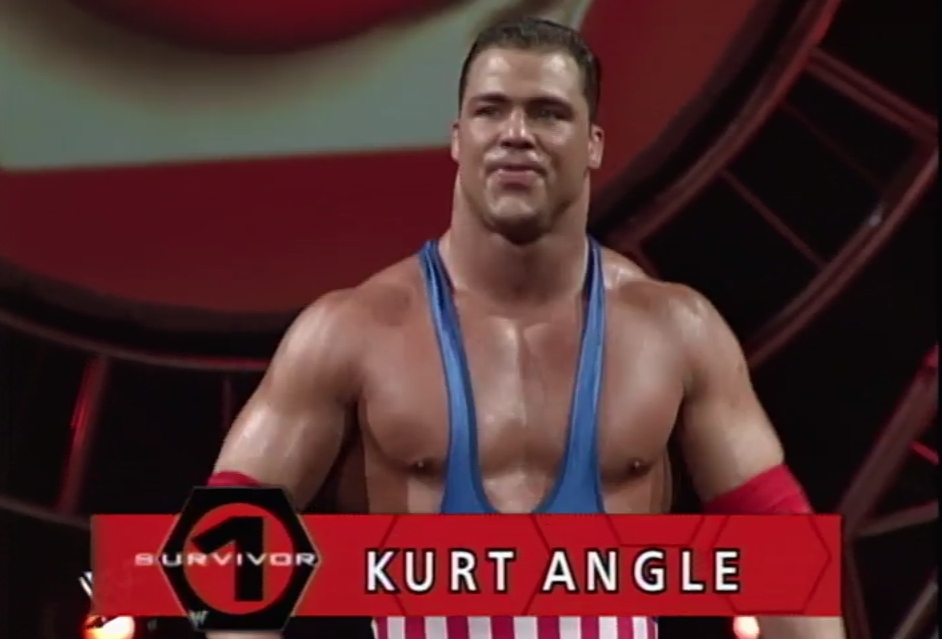
After an infamous failed courtship by ECW, Kurt Angle — former Olympic hero, who (in case you didn’t know) won a gold medal in freestyle wrestling with a broken freakin’ neck — began being hyped on WWF television in 1999 with some extremely subtle (especially by Attitude Era) vignettes that got over his just-a-little-too-haughty persona that would in short order be dialed up to 11 … and then several notches beyond. These vignettes hammered home the company’s tagline for Angle: “The most celebrated REAL athlete in WWF history,” with the emphasis always landing on “real.”
Vince McMahon and his various companies have always had a fascination (some would argue “obsession”) with a mainstream perception of “legitimacy.” Mark Henry was initially given a 10-year contract with no wrestling experience simply because he was a visible Olympian. So when an actual Olympic gold medalist was brought into the fold, longtime fans knew there was no way he wasn’t being given a lot of time and attention when it came to storylines and television exposure. In one of WWE’s earliest and most successful forays into self-reflexive metatext, they leaned into the knowledge that proclaiming one performer in the company the “real” one would rankle fans in real life and other wrestlers in storylines.
It certainly didn’t hurt that Angle just happened to be a generational talent as a professional wrestler, and one of the most charismatic performers and best actors the medium has ever seen.
Angle’s opponent for his televised debut was Shawn Stasiak, who was also making his pay-per-view debut after a few months in the company, when he was previously known as “Meat,” a boy-toy passed around by Pretty Mean Sisters, comprised of Jacqueline, Terri, and Ryan Shamrock. (1999 was a special time.) Stasiak’s Survivor Series entrance was followed by file footage of his father, Stan Stasiak, a former WWWF champion and master of the heart punch. This was a great touch, and an admirable Hail Mary attempt to partially legitimize a guy who weeks prior called himself “Meat,” wore gear designed to look like underwear, and had the gimmick of “this guy f*cks.”
Even all these years later, it’s still baffling that Kurt Angle made his WWE debut wrestling Shawn Stasiak on a pay-per-view. To put this in context, that would be like Kurt Angle wrestling Shawn Stasiak in his WWE debut.
Anyway, Angle, making his debut with a shockingly full head of hair, enters to “Medal,” in his trademark singlet, wearing his gold medal. All the pieces of Kurt Angle are already in place for all intents and purposes, although it’s a bit jarring to hear his theme without a chorus of “YOU SUCK”s accompanying it. Even stranger is the crowd at Joe Louis Arena in Detroit starting a large “LET’S GO RED WINGS” chant in the middle of this short match. Angle works from underneath for the bulk of the match, but when he gets the upper hand near the end, he departs the ring to grab the arena microphone and bark at the WWF fans, “You do not boo an Olympic gold medalist. I’m the best in the world! I came here for you! You do not boo me!” Masterful stuff, and just a glimpse at what was to come.
Angle hits a weird dropkick, Stasiak hits an even weirder falling-forward F5, and after Stasiak misses a crossbody, Angle hits his first Olympic/Angle slam for the three-count. After the match, Angle pulls his singlet straps down for the first time and celebrates. That began a winning streak for Angle that wouldn’t be snapped until the 2000 Royal Rumble in January, where he lost to the debuting Tazz. Very, very big things were in store for Angle in the coming year.
The World Champion
One year and five days later, Angle was defending the WWF Championship against the Undertaker. Yes, in the year between his first and his second Survivor Series, Angle would become the first Euro-Continental Champion, win the King of the Ring, and capture his first world title. He also leaned into both his obnoxiousness and his goofiness. He formed an alliance with Edge and Christian, climbed all the way up inside his own ass, and began doing just about anything to avoid having to wrestle matches fairly.
This was also right at the beginning of the Undertaker transitioning into his “American Badass” persona. In the video package recapping the Angle/Undertaker feud, Undertaker states, “I don’t dress like Satan anymore, but I’m still down with the devil.” This is also the era where he started working overtime on nicknames and catchphrases. He is the big dog, it is his yard, and he is the sole proprietor of Dead Man, Inc., you know. It should also be noted that the 2000 Survivor Series was celebrating the 10-year anniversary of Undertaker’s WWF debut, at the 1990 Survivor Series. The Undertaker character was 10 years old. That happened 18 years ago. The Undertaker is still wrestling.
If you need to know exactly how long ago the year 2000 was, please enjoy this photograph of Undertaker and frosted-tips Michael Cole.
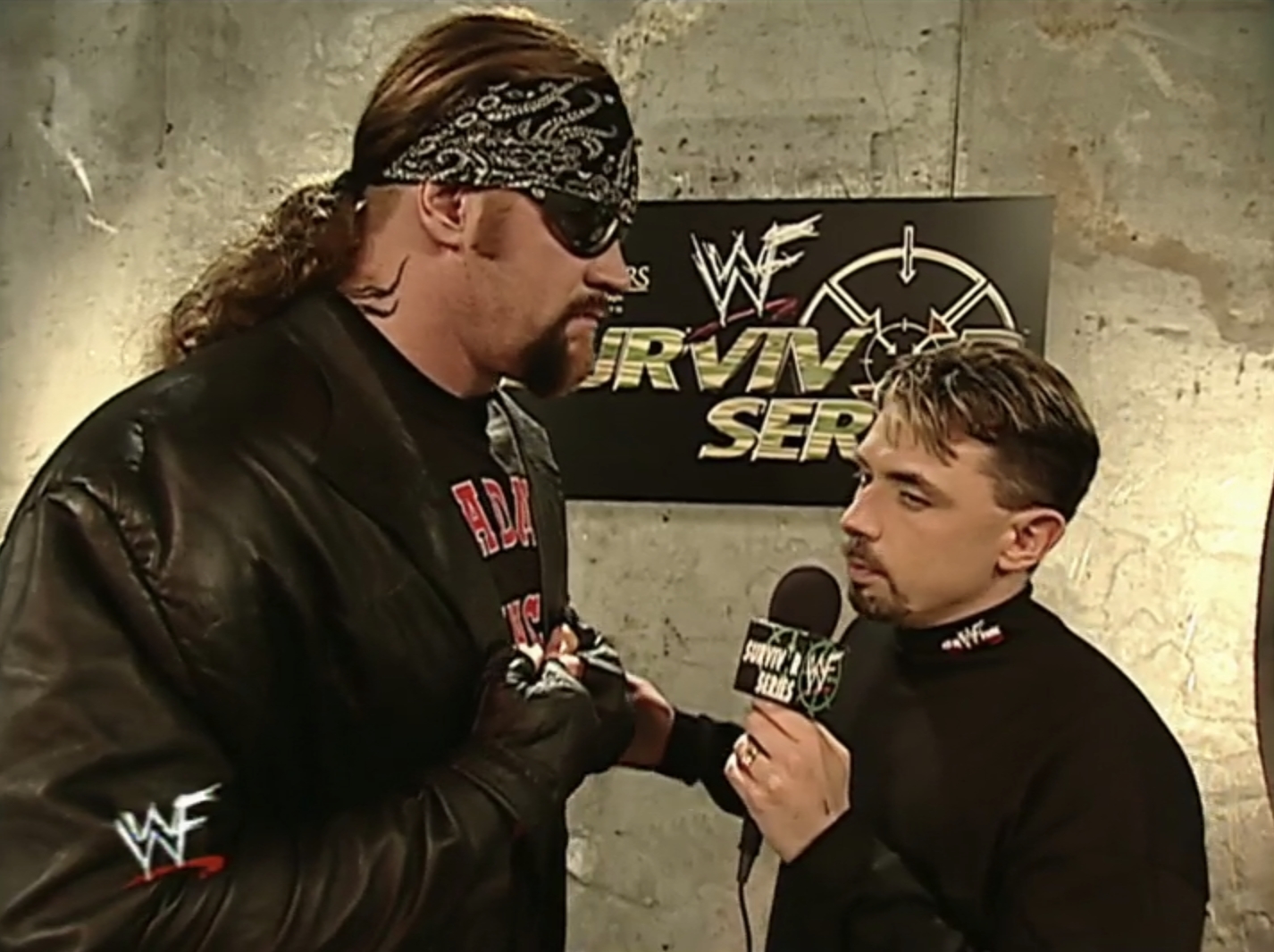
Also please enjoy the Undertaker’s weird, weird pants, which suggest that the “devil” he’s down with is probably the one from Stigmata, the most painfully 1999 film ever made.
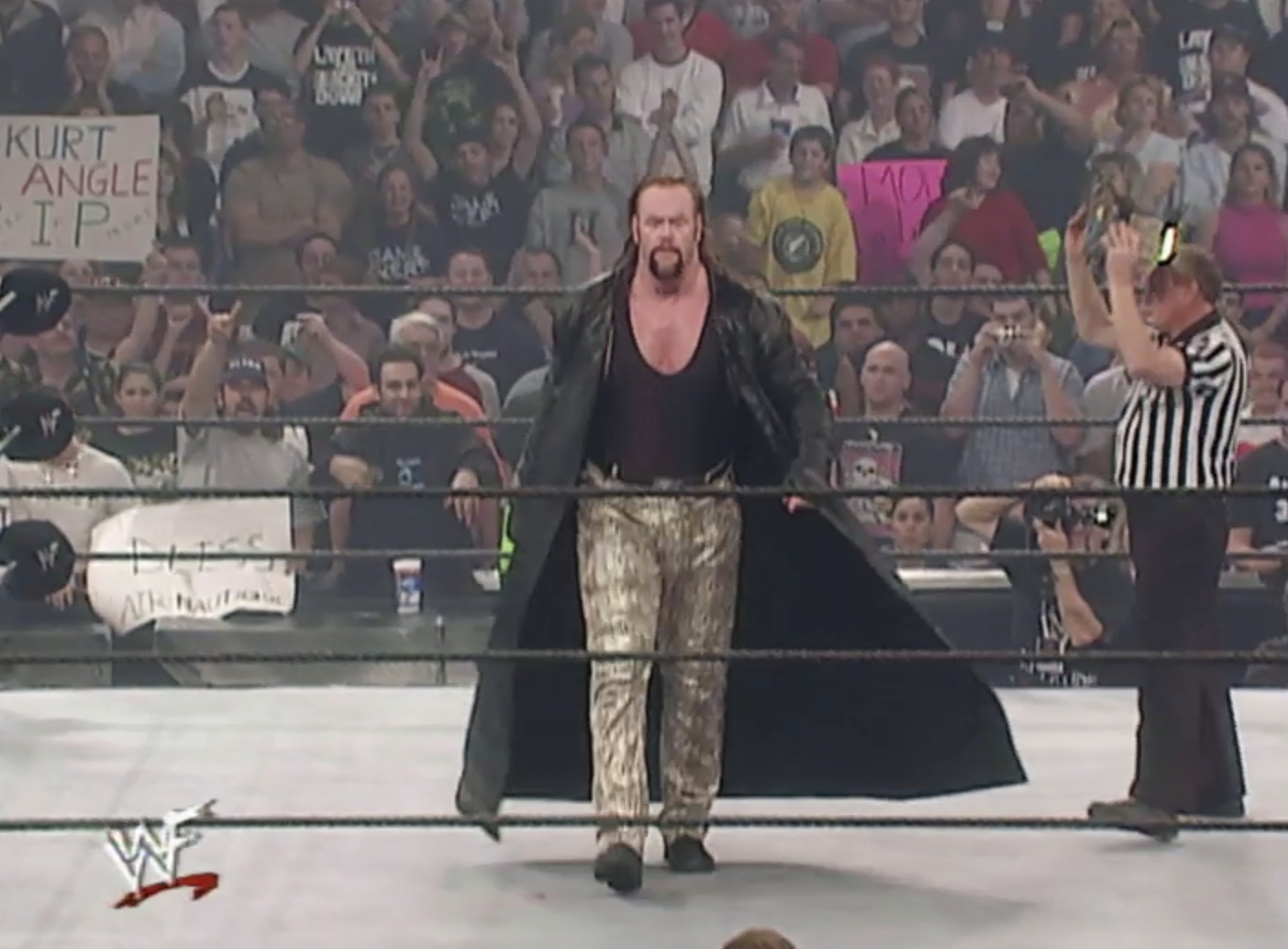
The match is a spectacularly one-sided affair, very much the hallmark of Angle’s first title run, where the character operated from a platform of immense privilege and expected good things to happen to him, always, so was often thoroughly overpowered and outmatched against opponents. This might stand in stark contrast to what you remember about the bulk of Angle’s career, but these are the bones of what made him who he is.
Undertaker has (an already staggeringly balding) Angle’s number from the jump, but Angle had so completely gotten under Taker’s skin that he felt the need to punish him in this bout. In the opening minutes, he picks Angle up from a certain pin, and beats him pillar to post. When Edge and Christian run out to cause a distraction, Angle taps out to an armbar behind the referee’s back. Kurt Angle. Tapping to an Undertaker armbar. Spectacular.
Eventually Angle retains due to possibly the most successful and well-executed Twin Magic of all time. Angle scurries under the ring, and Undertaker pulls him out, rolls him into the ring, delivers the Last Ride and pins him, but the referee recognizes that the person he’s pinning isn’t Kurt Angle. That allows Angle to slide into the ring and roll up Taker for the pin. The commentary team (and many of the fans) are left utterly baffled, as it’s not revealed until the next night on Raw that this is Kurt’s lookalike older brother, Eric Angle.
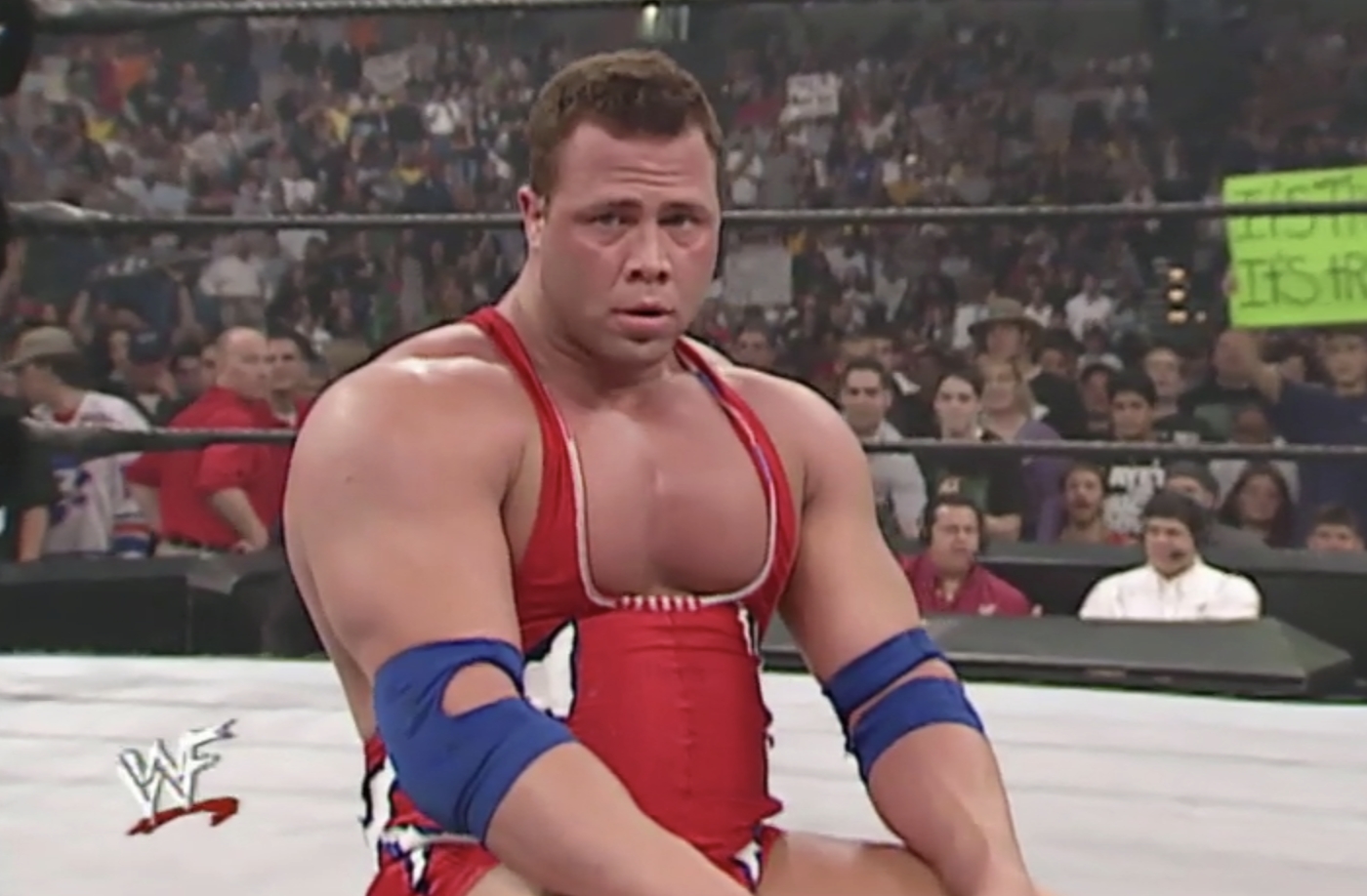
(For those of you who haven’t thought about “Kurt Angle’s brother” in a long time, I feel I must mention Eric Angle is not the older Angle brother who is currently in prison for homicide. That’s David Angle.)
The Alliance
One year later, Angle would finally be in the main event of Survivor Series for the one and only time. (The 2000 Survivor Series was not headlined by Angle vs. Undertaker, it was headline by a No Disqualification Match between Steve Austin and Triple H. That match ended in a no contest, by the way, when Triple H used a forklift to pick up a car Triple H was in and drop it on its roof. Gotta love that Attitude Era.)
The 2001 Survivor Series was the culmination of the widely-derided Invasion storyline, with the main event being a winner-take-all match for control of the WWF, WCW, and ECW brands. Team WWF was comprised of Chris Jericho, the Big Show, Kane, the Rock, and the Undertaker, while Team Alliance was Kurt Angle, Steve Austin, Booker T, Rob Van Dam, and Shane McMahon. Yes, we all know the Alliance team was mostly made up of WWE wrestlers. It’s fine.
This was arguably the most beloved stretch of Angle’s career, as it gave us the tiny cowboy hat and “Jimmy Crack Corn.” Angle and Austin were terrific at being allies who got on each other’s nerves, and it seems like we really should have gotten more Angle vs. Austin over the years. Alas.
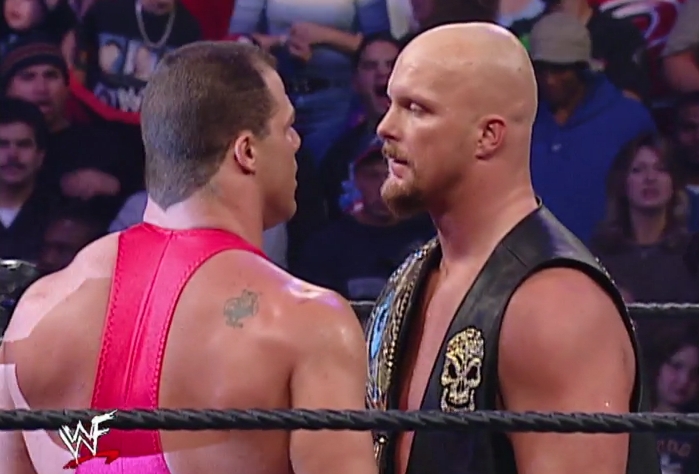
Angle got one elimination in the main event (pinning Undertaker after Austin hit the Dead Man with a Stunner) and was eliminated by the Rock’s legendary terrible Sharpshooter. The match ultimately came down to Rock vs. Austin, as all things do, but Angle returned to hit Austin with the WWF Championship and give Rock and WWF the victory, forcing the Alliance to disband. This ultimately led to the creation of the brand split, which in turn led to the version of Kurt Angle that exists in some form today.
The Smackdown Six
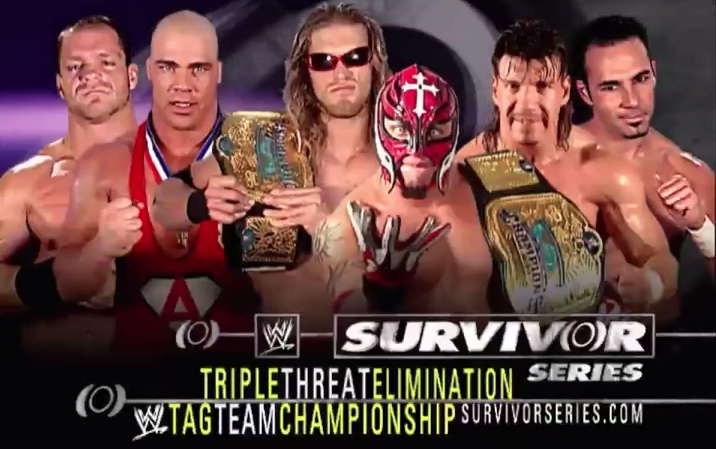
By the 2002 Survivor Series, Angle was bald (thanks to a feud with Edge), the brand split was in full effect, and the beloved “Smackdown Six” of Edge, Angle, Rey Mysterio, Chris Benoit, and Eddie and Chavo Guerrero was in full effect. Smackdown became the home of “good” wrestling, while Raw became the home of spectacle and whatever else WWE was doing at the time. Angle’s match at the 2002 Survivor Series tossed the entire Smackdown Six into one match, as tag champs Edge and Mysterio defended their titles in a Triple Threat elimination match against Los Guerreros and the CAN THEY COEXIST frenemies Angle and Benoit.
Further context for what was happening at this time: In the match immediately preceding this, Paul Heyman turned on Brock Lesnar to allow Big Show to win the WWE Championship, and the main event of the evening was the first-ever Elimination Chamber match saw Shawn Michaels capture the WWE World Heavyweight Championship by outlasting Triple H, Rob Van Dam, Booker T, Chris Jericho, and Kane. (Please also enjoy Michael Cole digivolving into leather jacket super-cool 2002 Michael Cole, which may be even worse than the frosted tips version.)
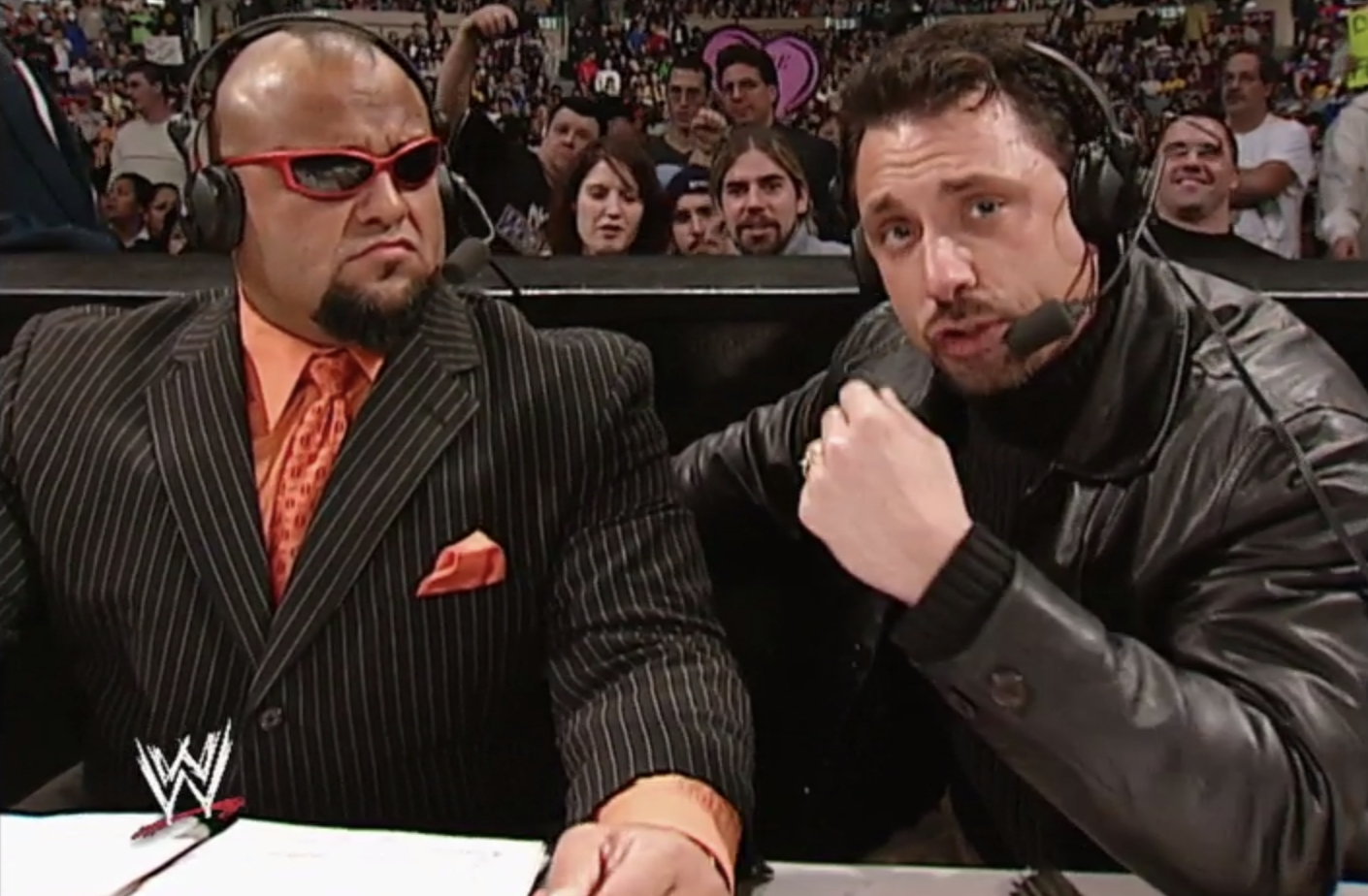
The triple threat match is good, although maybe not as good as you’d expect going back and watching it 16 years later. Even back then, Mysterio was fiddling with his mask every other moment, Edge was still finding his footing as a performer, and everyone was surprisingly loosey-goosey throughout. Benoit and Angle were eliminated first, as Chavo hit Benoit with one of the tag titles while Benoit was actively looking at Angle, yet somehow thought Angle struck him. The other teams took advantage to eliminate Angle and Benoit, although the grapples laid out everyone before departing. The Guerreros eventually walked away with the titles, and maybe the most remarkable thing about the event was how amazing the early-2000s Madison Square Garden “big show” setup was.
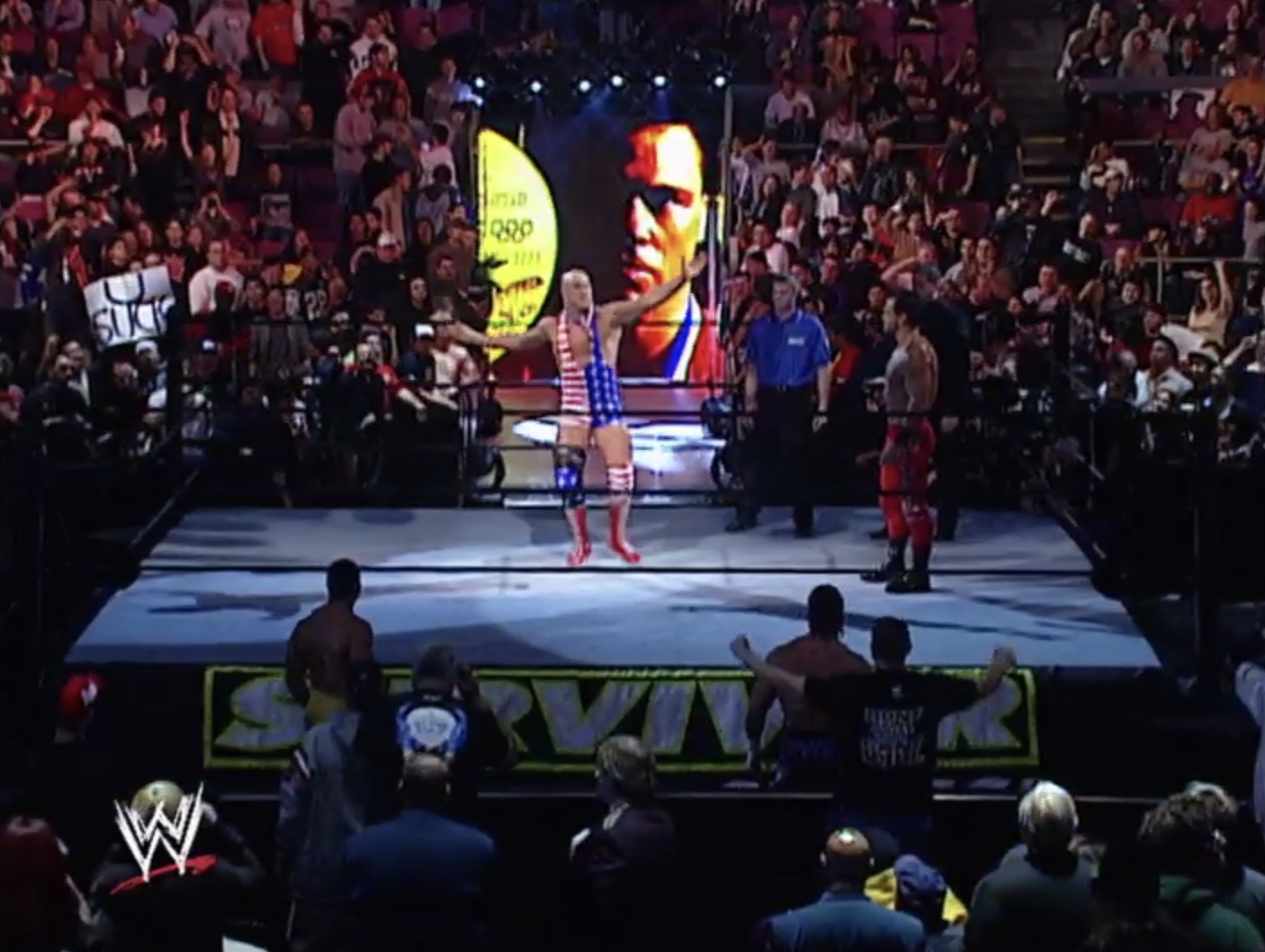
Bring that back, please. Somehow. Heck, maybe ROH can do a similar setup for their MSG show on WrestleMania weekend.
The Team Angle Years
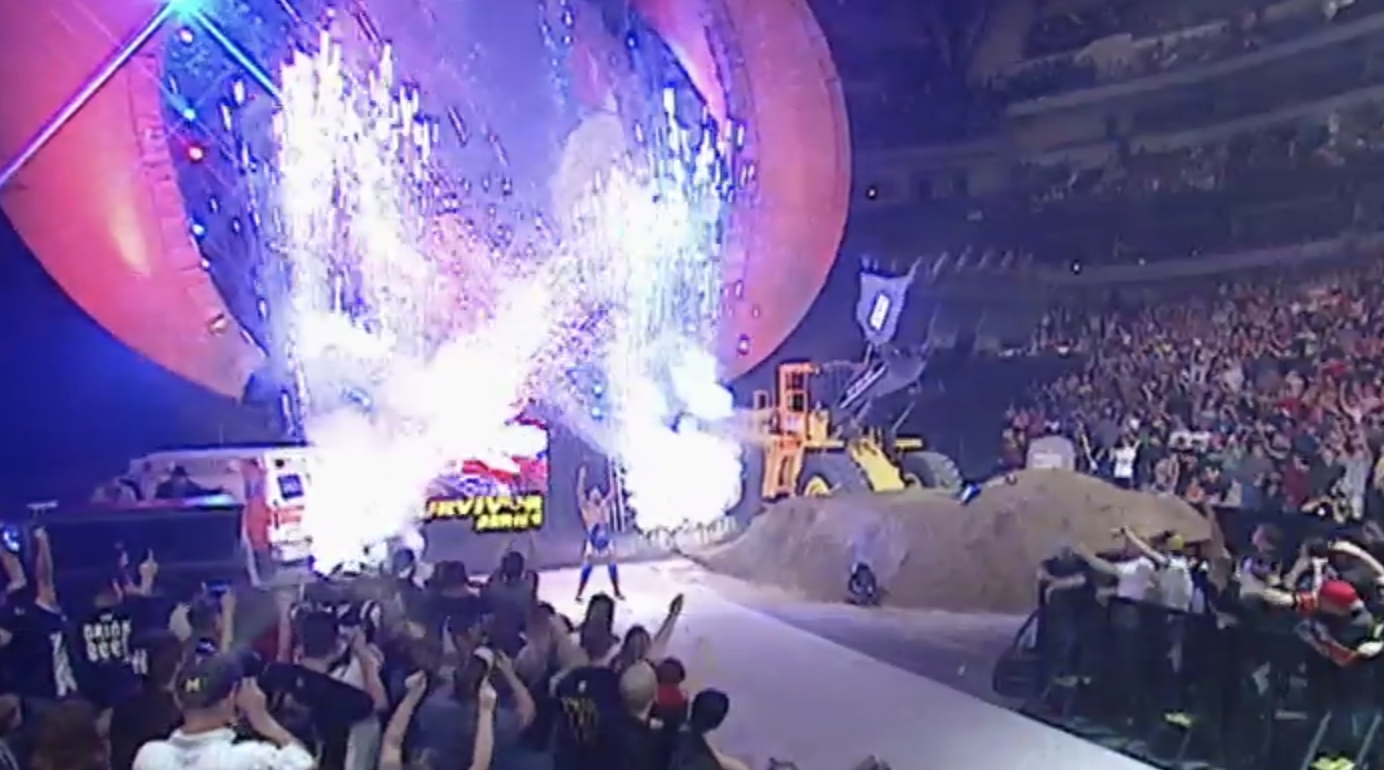
The next two years saw Angle captaining different “Team Angle” Survivor Series teams, although perhaps a bit surprisingly, the actual Team Angle of Angle, Shelton Benjamin and Charlie Haas never once appeared together at Survivor Series.
2003 saw one of the weirdest hodgepodges of teams ever going at it in the opener, as Team Lesnar assembled a team of massive giants (purportedly the heaviest team ever assembled, but there’s no way that’s right given the days of King Kong Bundy, Bam Bam Bigelow, the Twin Towers, et al). WWE Champion Brock Lesnar (again, working in the opening match) teamed with Big Show, Nathan Jones, Matt Morgan and A-Train against what was assumedly a more technically-sound team of Angle, Hardcore Holly, Chris Benoit, John Cena, and the weird late-APA short-haired version of Bradshaw (who was replacing Faarooq).
Cena, already on his way to being a megastar, opened the show with one of his worst “raps” ever, and the layout of this match was baffling. Lesnar and Holly had the most pressing and heated feud heading into the match, as Holly was returning after having his neck broken by Lesnar. Holly jumped Lesnar during Brock’s ring-jump pyro and beat him down outside before the bell rang, but the referee determined Holly was beating him up too much, and must thus be disqualified. Before the opening bell rang. Bradshaw then immediately hit a lariat on A-Train and pinned him, then was immediately caught and pinned by a Big Show chokeslam. The match settled in, and it really has to be mentioned what an absolute monstrosity Nathan Jones was. Imagine if that guy was any good at all in the ring. Like if Brian Cage was a foot and a half taller. Terrifying.
Angle eliminated Jones and Morgan, and was himself eliminated after an F5. World champion Lesnar was tapped out by the Crippler Crossface, and Cena hit Big Show with a chain and an FU to leave him and Benoit as the sole survivors. Benoit offered the rare Respect Handshake to Cena, starting the beginning of the push that led to all-caps JOHN CENA as we know and occasionally love him now.
(One other strange production thing about the 2003 Survivor Series: the WrestleMania XX sign was hung in its customary place … in November. They were actively building to WrestleMania in November. Imagine!)
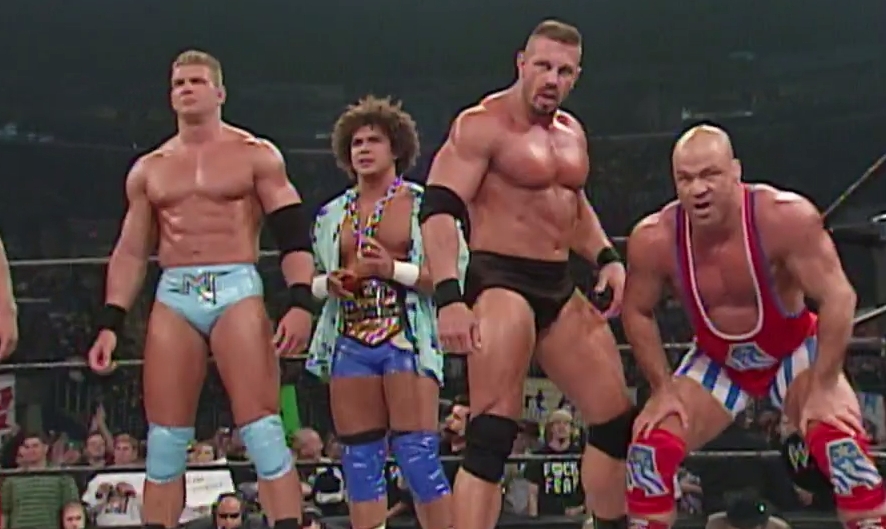
2004’s Team Angle was even weirder, as Angle gathered together Luther Reigns, Mark Jindrak and Carlito Caribbean Cool (with Jesus) to take on Team Guerrero of Eddie Guerrero, Rob Van Dam, Big Show (whom Angle, Jindrak, and Reigns had attacked with a tranquilizer dart to shave Big Show’s head — for the first time — and then again to injure his foot), and the returning John Cena, who had been “stabbed” by Jesus and Carlito outside an “after-hours club.” There were a few years in there where any quasi-legitimate grappler was stuck with Angle for a time to try and make him pro wres-legitimate. It was a reasonable gamble that almost never paid off, but god bless them for trying.
Most of the match took a back seat to the Cena vs. Carlito beef, as Carlito and Jesus seemed shocked that Cena would actually show up for his advertised match. Before the match began, Cena beat them both into the parking garage, and then they stole a car and fled. I don’t know if leaving the arena in a stolen car constitutes forfeiting your part in an elimination tag match, but they were never mentioned again.
The rest of the match was pretty much a non-affair, as Angle used a rope-assisted roll-up to pin RVD for his team’s only elimination, and was eventually cornered by Team Guerrero and given a three-pronged finisher assault to be the last member of Team Angle eliminated. These were the lost Survivor Series years for Angle, although it’s important to note that these two key matches, in addition to Cena’s “Ruthless. Aggression.” debut, showed what a vital role Angle played in the rise of John Cena.
Speaking of John Cena!
The Wrestling Machine
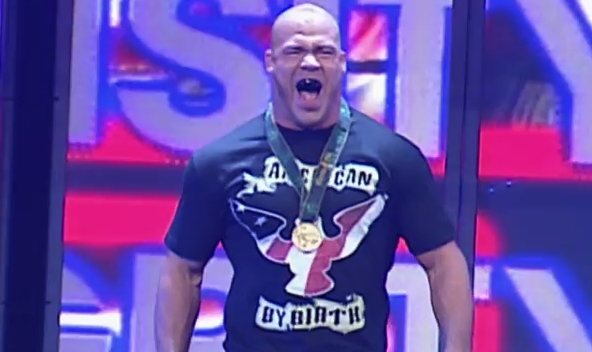
Yes, he wouldn’t actually adopt the “Wrestling Machine” moniker officially until his move to ECW in 2006 (just before his departure from WWE), but the late phase of Angle’s initial WWE tenure is very much defined by him being an ass-kicker who kept getting waylaid by lack of focus, a poor temper, and a sense of entitlement. (I am, of course, referring to the character of Kurt Angle when I say those things. The actual Kurt Angle has always been driven, often to a fault.)
In 2005, Kurt Angle’s final Survivor Series during his first WWE run (he would leave the company in August of 2006), Angle competed for John Cena’s WWE Championship. And in a wrinkle that I definitely did not remember, Shawn Daivari was Angle’s hand-picked special referee for this match, because Daivari was in league with Angle (and Eric Bischoff) for a while, and would later become Angle’s manager for a time.
This was arguably the apex of Cena as an absolute beloved babyface, and Angle was at the height of his powers as a miserable prick who insisted on taking shortcuts despite being immensely talented. Jarring until you realize it’s hilarious are the bleeps over the “You Suck” chants during Angle’s entrance, as commentary helpfully points out that Angle and Bischoff have successfully censored the “fan profanity” heaped upon Angle. The fact that none of the bleeps are timed correctly despite the chants having a definite cadence is really the icing on the cake.
The crowd is absolutely ravenous for Cena to get the win here, and Angle and Daivari go into overtime using every nefarious tactic at their disposal. At the end of the match, Smackdown referee Charles Robinson actually has to emphatically step around the bodies of three Raw referees in the ring to successfully count the pinfall that defeats Angle. This one is worth a watch for how intensely the WWE fans loved Cena and hated Angle at this point, and the over-the-top heel antics that are so bad they’re good. A worthy sendoff to Angle’s Survivor Series career, even if he never had a classic at the event.
But there is another.
The Return
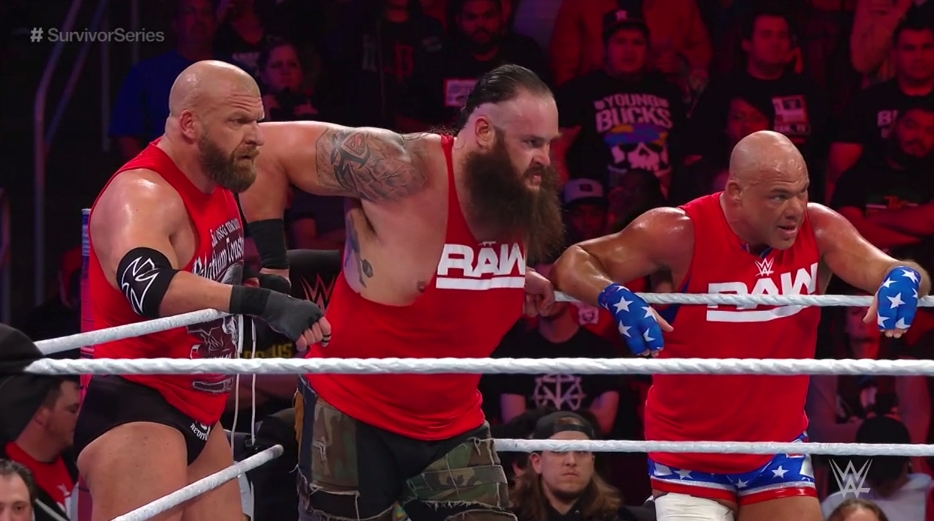
Last year, after making his in-ring return to replace an ill Roman Reigns in a quasi-Shield reunion, Raw general manager Kurt Angle headed up Team Raw in the main event of his first Survivor Series in 12 years. This was the match that introduced us to Kurt Angle’s weird, sad mittens, and it was also revealed after the fact that he worked this match with a pretty wonky leg.
The years of wrestling with maximum effort in TNA when he probably should have slowed down a little bit had clearly taken their toll, although a 48-year-old Angle with a bad leg wasn’t helped any by the bizarre booking of the match. The early portions of the bout were spectacular, as we saw dream interactions involving Shinsuke Nakamura, Samoa Joe, Finn Bálor, Triple H and Bobby Roode, but the match came down to Shane McMahon against Angle, Triple H and Braun Strowman. Triple H turned on Angle, allowing McMahon to get the pin before being eliminated and leaving Triple H and Strowman as the sole survivors. This, of course, nicely set up the WrestleMania 34 ACTUAL main event of Triple H and Stephanie McMahon vs. Kurt Angle and Ronda Rousey, so everything worked out. They were actively building to WrestleMania in November. Imagine!
As is usually the case with a wrestling career, things wind down, and if you’re beloved enough, you get to take a victory lap or two. Or ten. It’s likely we haven’t seen Angle’s last match, but it’s possible we’ve seen his final Survivor Series. While Angle’s history at the event isn’t stellar, it is important, and more importantly, taken together, his Survivor Series appearances pretty much tell the complete story of his entire WWE career. And that’s a remarkable feat in itself.

